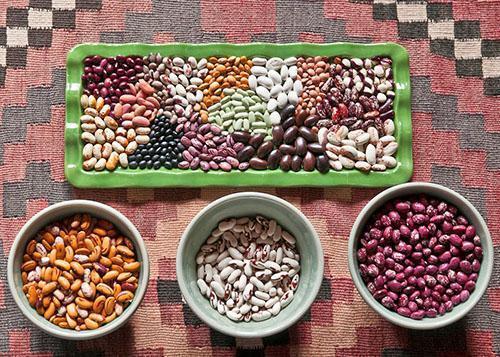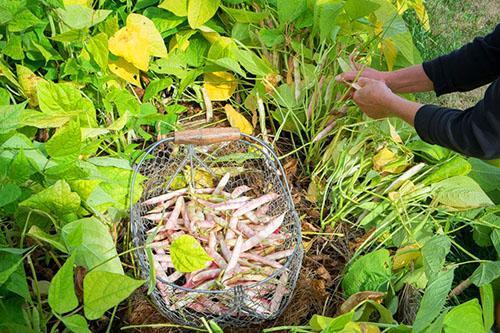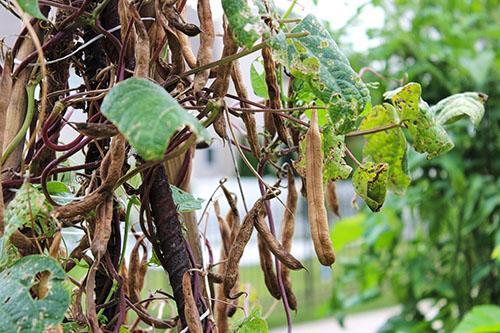To prepare beans for the winter, you need to know how to dry them.
 Bean seeds, rich in protein, carbohydrates, amino acids and vitamins, are comparable in nutritional value only to meat, which means they deserve to take an honorable place in the diet of healthy people, and those who have been diagnosed with diseases of the heart, urinary tract and digestive tract. In addition to seeds, dry leaves, which are used for diabetes mellitus treatment.
Bean seeds, rich in protein, carbohydrates, amino acids and vitamins, are comparable in nutritional value only to meat, which means they deserve to take an honorable place in the diet of healthy people, and those who have been diagnosed with diseases of the heart, urinary tract and digestive tract. In addition to seeds, dry leaves, which are used for diabetes mellitus treatment.
How to prepare beans for the winter?

Juicy pods and green beans are harvested for the winter, frozen and canned. At home, mature beans are easiest to shell and dry. This will leave the maximum amount of useful components in the vegetables. The main thing is to properly store the beans in winter and to protect the grown crop from possible damage.
The collection of beans intended for drying is carried out in August and September, when the shutters change color and lose their juiciness.
The drier the pods are at the time of harvest, the easier it is for the seeds to leave the shells during peeling and the less time it takes to dry them. However, it is important to remember that the pods of some varieties and species open on their own when ripe, and the seeds quickly fall to the ground.
 Beans removed for winter storage in pods:
Beans removed for winter storage in pods:
- sort out, removing beans with signs of spoilage, the presence of pests and diseases;
- laid out in a ventilated shaded room for drying.
 When the harvest is massive, or the harvesting of beans for the winter takes place at the end of the growing season, the withered tops are uprooted and all the pods on the bush. In this form, bean plants are dried by hanging them under awnings and first spreading clean cloth or paper under them. This measure will allow you to save even those seeds that fall out of the opened pods.
When the harvest is massive, or the harvesting of beans for the winter takes place at the end of the growing season, the withered tops are uprooted and all the pods on the bush. In this form, bean plants are dried by hanging them under awnings and first spreading clean cloth or paper under them. This measure will allow you to save even those seeds that fall out of the opened pods.
If, after hulling, it turns out that not all the seeds are sufficiently hard and mature, they can be brought to readiness at room temperature or, depending on the degree of maturity, discarded.
The sorting process removes not only sluggish, soft to the touch seeds, but also those that show signs of mold, dark spots or insect holes.
How to store beans in winter?
 The main danger during winter storage of beans is:
The main danger during winter storage of beans is:
- damage bean weevilwhose larvae end up inside the bean during the summer months;
- the development of mold fungi and rot, when moisture gets into containers with seeds.
When the beans harvested for the winter are well dried and scattered in glass jars with tight-fitting lids, in a cool dry room the risk of rotting and spoilage of beans is many times reduced.
 But pest bugs are one of the most serious problems. With a massive defeat by this pest, several dozen larvae develop inside one pod in summer, which, finding a seed, penetrate and develop, feeding on beans and making passages in it. By the time of pupation, there may be practically no pulp left under the seed coat. As a result, beans lose not only germination, but also all nutritional and taste qualities.
But pest bugs are one of the most serious problems. With a massive defeat by this pest, several dozen larvae develop inside one pod in summer, which, finding a seed, penetrate and develop, feeding on beans and making passages in it. By the time of pupation, there may be practically no pulp left under the seed coat. As a result, beans lose not only germination, but also all nutritional and taste qualities.
Through the peel of the seed, traces of the pest stay are clearly visible, and sometimes rounded holes are visible on the surface - this is the place where adult beetles exit. Under favorable conditions, the caryopsis can give up to four generations per season and cause serious damage to the gardener.
Beetle larvae trapped in jars of beans remain viable at temperatures ranging from 10 to 48 ° C. And a tight lid will not save you from damage intended for winter storage of beans, if you do not take more effective measures.
If the beans on the site are grown exclusively for grain, and green pods are not eaten, then it is reasonable to use insecticides to combat the bean weevil. This event, carried out during the flowering stage or in the early days of pod formation, will effectively protect future crops.
Also, do not wait for the moment when the ripe beans begin to spontaneously open, which facilitates the access of ready-to-lay female weevils to the seeds. Beans are harvested for the winter only in strong pods. And when grains fall on the ground, you should not collect material that may be infected with a pest.
 At home, before drying the beans, the obviously unusable beans and seeds are removed. And then, to kill the larvae, split beans, turned, are heated in an oven or dryer at a temperature of 50–55 ° C. In 20-30 minutes, the pest in the larval stage is destroyed under such conditions. If the temperature is higher, the seeds will lose their germination, but when using beans only for food purposes, you can hedge without harm to the taste of the grain.
At home, before drying the beans, the obviously unusable beans and seeds are removed. And then, to kill the larvae, split beans, turned, are heated in an oven or dryer at a temperature of 50–55 ° C. In 20-30 minutes, the pest in the larval stage is destroyed under such conditions. If the temperature is higher, the seeds will lose their germination, but when using beans only for food purposes, you can hedge without harm to the taste of the grain.
At temperatures below 10 ° C, larvae also do not develop, which means that one of the ways to store beans in winter is a household refrigerator or unheated dry rooms where there is ventilation:
- Dried beans, disinfected by high temperature or intended for storage in the refrigerator, are poured into glass jars and tightly closed.
- For storing beans in winter at subzero temperatures, for example, on the balcony of a city apartment, it is better to use thick linen bags, but protect the seeds from getting wet.
 Unpeeled will help scare away pests from beans clove of garlic and dry fennel and dill seeds. The shelf life of beans, depending on the variety, is from 4 to 12 months.
Unpeeled will help scare away pests from beans clove of garlic and dry fennel and dill seeds. The shelf life of beans, depending on the variety, is from 4 to 12 months.
How to dry beans for medicinal purposes?
 For the use of beans for medical purposes, the raw materials obtained after hulling are sorted out, removing rotten or spoiled by pests, and then dried.
For the use of beans for medical purposes, the raw materials obtained after hulling are sorted out, removing rotten or spoiled by pests, and then dried.
It is better to dry the bean flaps under a canopy, where there is no direct sunlight and wind, but the air does not stagnate.
When the beans' lids become brittle, they are poured into cardboard boxes or dry tight bags for later storage in the winter. You can use such raw materials for medicinal decoctions and infusions until the next harvest.
Today, electric dryers for vegetables and fruits are increasingly used in everyday life. Therefore, more and more often the question arises: "Is it possible to prepare beans for the winter by drying the green pods?"
Indeed, drying allows you to preserve a lot of useful properties and qualities in the product. Green beans are no exception. It lends itself well to drying on gentle modes and temperatures up to 65 ° C, but after that you will not be able to cook a truly summer dish from such a product. The fact is that after drying, the pod tissue is not able to restore its consistency and retain as much moisture as was in the sugar scoop.
Therefore, dried bean pods can be used to add to soups, stews and other dishes, but not served as a side dish on their own.
 It is much more useful and easier to freeze juicy asparagus blades, which are pre-blanched, then dried and stored in the freezer. The same is done with green seeds, for example, lima beans, which are boiled, stewed and served as a side dish for fish and poultry in winter.
It is much more useful and easier to freeze juicy asparagus blades, which are pre-blanched, then dried and stored in the freezer. The same is done with green seeds, for example, lima beans, which are boiled, stewed and served as a side dish for fish and poultry in winter.